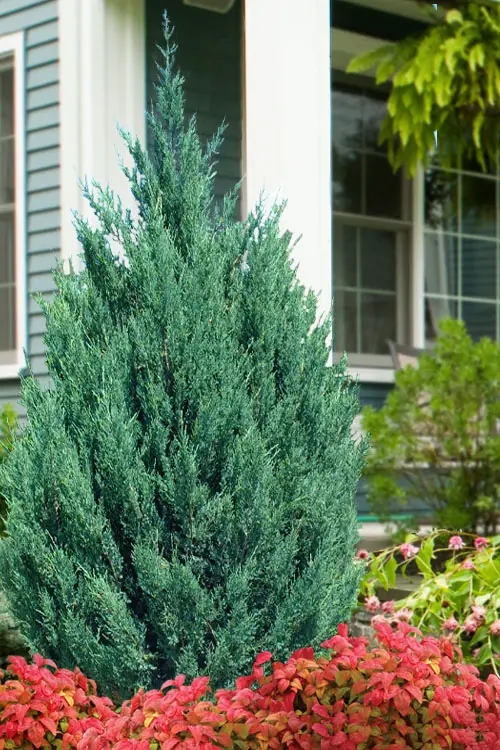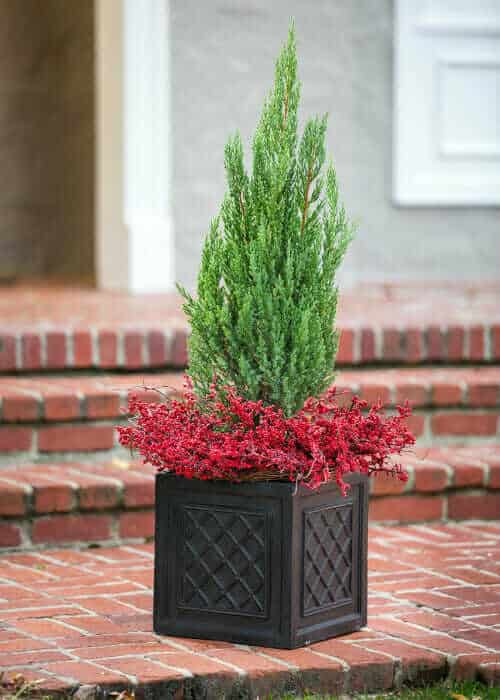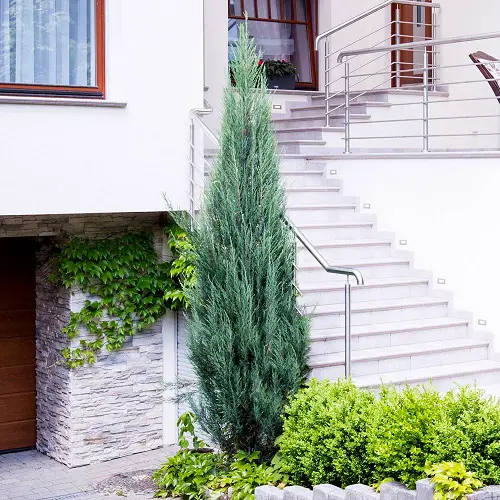Blue Point Juniper is a eye catching specimen that can be a great option for both garden and containers! Here are the details to grow it!
Discover the ultimate solution for privacy and beauty with the Blue Point Juniper! Its versatility and lush growth make it the ideal screening plant. Enjoy both aesthetics and seclusion with this remarkable choice.
Botanical Name: Juniperus chinensis ‘Blue Point’
Common Names: Juniper, Blue point Juniper
USDA Zones: 4a – 9b
Check out Best Backyard Fence Ideas for Privacy here
Blue Point Juniper Information
The Blue Point Juniper (Juniperus chinensis ‘Blue Point’) is a popular evergreen shrub that is widely used in landscaping.
Origin
- Scientific Name: Juniperus chinensis ‘Blue Point’
- Native Region: This particular cultivar has been developed from species native to Northeast Asia, including China, Mongolia, Japan, and Korea.
Height
- Mature Height: Blue Point Juniper typically grows to a height of 10 to 12 feet, making it suitable for privacy screens or tall hedges.
- Growth Rate: It has a moderate growth rate and can add around 6 to 8 inches per year once established.
Appearance
- Foliage: The foliage of the Blue Point Juniper is a beautiful bluish-green color, consisting of tightly packed, needle-like leaves.
- Shape: It features a pyramidal and dense shape, giving it an elegant and uniform appearance.
- Texture: The texture is somewhat fine to medium, with a soft, feathery appearance.
- Cones: The plant produces small, berry-like cones that are often a bluish-black color.
Spread
- Mature Spread: The Blue Point Juniper has a spread of 4 to 6 feet at maturity. Its upright growth habit and moderate spread make it suitable for narrow spaces or planting in rows for windbreaks or privacy screens.
- Spacing: If planted in a row, a spacing of 3 to 4 feet between plants is recommended to allow for healthy growth.
Check Tall Grass Privacy Ideas here
Propagating Blue Point Juniper
Different methods to propagate Blue Point Juniper:
Cuttings: This involves taking a stem cutting from a mature Blue Point Juniper and rooting it to create a new plant.
Layering: Layering is done by bending a low branch of the juniper to the ground, making a small wound on the branch, and covering it with soil. Once roots form at the wounded area, the branch can be cut from the parent plant and potted.
Seeds: Growing Blue Point Junipers from seeds is another propagation method, although it can be more time-consuming and less reliable compared to other methods.
Easiest Method: From Cuttings
- When taking a cutting, aim for a length between 20cm and 25cm (8-10 inches). It’s important to choose a healthy branch. This branch should have a good number of needles at its tip. Remember to remove the bottom 5cm (2 inches) of needles from the cut end of the branch piece.
- To help the cutting grow roots, you can make small slits in the outer layer of the branch. These slits should be about 2.5cm to 5cm (1- 2 inches) long. It’s a good idea to make these slits on both sides of the exposed part of the branch. This way, the branch can absorb more water, which encourages root growth.
- To begin the propagation process, plant the cutting in a mix of all-purpose soil and sand. Find a bright spot with high humidity, maintaining a temperature around 20°C (68°F). Keep the soil consistently moist.
- By the time spring arrives, roots should have developed, indicating that the juniper cutting is ready for the next step—repotting or moving it outdoors.
Tip: When you’re choosing a cutting for propagation, select one from the main shoot of the juniper. This is because conifer shoots retain the memory of their growth direction, unlike a side shoot, which might not grow straight upward after being propagated.
Check Best Tall Grasses for Privacy here
Best Pot Size for Growing Blue Point Juniper
1. Small Blue Point Juniper (Young Plant):
If you’re starting with a young Blue Point Juniper that’s around 1 to 2 feet tall, a pot with a diameter of 10 to 12 inches and a depth of 8 to 10 inches should be sufficient for the first year or so.
2. Medium Blue Point Juniper (Growing Plant):
For a Blue Point Juniper that has reached a height of around 2 to 4 feet, consider a pot with a diameter of 14 to 18 inches and a depth of 10 to 12 inches. This will provide enough space for further growth.
3. Mature Blue Point Juniper (Larger Plant):
If you have a mature Blue Point Juniper that’s larger, around 4 to 6 feet tall, you’ll need a larger pot. A pot with a diameter of 18 to 24 inches and a depth of 12 to 15 inches would be appropriate. More mature trees can even be planted in much bigger 30 inches pots.
Important Considerations:
- Make sure the pot you choose has drainage holes to prevent water from accumulating and causing root rot.
- When repotting, choose a pot that is about 2 inches larger in diameter than the current pot. This allows for some root growth without overwhelming the plant.
- Blue Point Junipers have a slow to moderate growth rate so that they won’t outgrow their pots too quickly. However, periodic repotting or root pruning may still be necessary as the plant grows to ensure its health.
- Use a well-draining potting mix designed for succulents or cacti to ensure proper water drainage.
Check the Best Privacy Fence Ideas for Backyards here
Requirements to Grow Blue Point Juniper
Sunlight
- Ideal Conditions: Blue Point Juniper thrives best in full sun, where it can receive at least 6 to 8 hours of direct sunlight daily.
- Impact on Growth: Full sun exposure promotes healthy growth, vibrant blue-green foliage, and maintains the plant’s dense, pyramidal shape.
- Consideration in Different Zones: In cooler Northern regions, positioning the plant in a location with maximum sunlight is crucial. In hotter Southern regions, a site with some afternoon shade may help prevent potential stress during the hottest parts of the summer.
Soil
- Ideal Conditions: Well-draining soil is essential for Blue Point Juniper. It can adapt to various soil types, including sandy, loamy, and clay soils.
- pH Levels: A slightly acidic to neutral pH range of 5.5 to 7.0 is preferred.
Garden Soil Mix:
- 2 parts garden soil
- 1 part sand or perlite
- 1 part compost (optional for added drainage)
Potting Soil Mix (For planting in containers)
- 2 parts potting soil
- 1 part sand or perlite
- Add a layer of gravel at the bottom of the pot for extra drainage
Water
- Newly Planted: Water deeply once or twice a week until established.
- Mature Plants: Drought-tolerant once established, water every 2 to 3 weeks or when the soil becomes dry.
Watering Technique
- Deep Watering: Encourage deep root growth by watering thoroughly, allowing the soil to dry slightly between waterings.
- Climate: In hotter regions, more frequent watering may be required.
- Avoid Overwatering: Overwatering can lead to root rot, so ensure proper drainage.
Temperature
- USDA Zones: Blue Point Juniper grows best in USDA hardiness zones 4 through 9.
- Tolerance: It is tolerant of cold winters and hot summers within these zones.
- Heat: In extreme heat, ensure adequate watering and consider a location with some afternoon shade.
- Cold: In colder regions, the plant is generally winter-hardy but may benefit from protection from harsh winter winds.
Blue Point Juniper Care
Fertilizer
- Generally Low: Blue Point Juniper is not very demanding in terms of fertilization.
- Assessing Soil: Soil testing can guide whether and what type of fertilization is needed.
Best Homemade Fertilizer Options
- Compost: Well-rotted compost can provide essential nutrients.
- Organic Matter: Incorporating organic matter like manure can improve soil fertility.
Commercial Fertilizer Options
- Balanced Slow-Release Fertilizers: Products like Osmocote or a granular fertilizer with an N-P-K ratio of 14-14-14 can be effective.
- Evergreen-Specific Fertilizers: Formulations designed specifically for junipers or evergreens can also be suitable.
Timing
- Spring Fertilization: Apply fertilizer in early spring, just before new growth begins.
- Fall Feeding: A second application in early fall can support growth but is generally optional.
- Quantity: Follow the instructions on the fertilizer packaging, as different products have varying recommendations.
- Avoid Contact with Foliage: Ensure the fertilizer does not come in direct contact with the foliage to prevent burning.
Pruning
- Shape Maintenance: Pruning can help maintain the desired pyramidal shape but is generally not necessary for health.
- Timing: Late winter to early spring, before new growth begins, is the best time to prune.
- Selective Pruning: Remove unwanted branches at their base without cutting into the old wood.
- Avoid Over-pruning: Excessive pruning can lead to bare spots, as junipers do not always regenerate from old wood.
Pests and Diseases
Common Pests
- Spider Mites: These can cause discoloration; spraying with a strong water jet or using miticides can control them.
- Juniper Scale: Horticultural oils can manage these insects.
Common Diseases
- Phytophthora Root Rot: Avoid planting in waterlogged soil, and provide proper drainage.
- Cedar-Apple Rust: Removing affected areas and using fungicides can control this fungus.
Prevention
- Proper Care: Healthy plants are less susceptible to pests and diseases, so proper watering, sunlight, and soil conditions are key.
- Regular Monitoring: Regularly check for signs of pests and diseases for early detection and treatment.
Check Best Plants for Privacy in Florida here
Landscape Uses Of Blue Point Juniper
1. As a Striking Focal Point
The pyramidal shape and impressive size of the Blue Point Juniper make it an ideal choice for creating captivating focal points within lawns. Its unique form draws attention, adding a touch of elegance and visual interest that enhances the overall landscape design.
2. Use it as an Architectural Framing
Positioning Blue Point Junipers to frame entrances and driveways adds a touch of sophistication to any property. It’s dense foliage and graceful growth create an attractive frame that guides the eye and lends an inviting aura to the entrance.
3. Privacy Screen
Utilizing the Blue Point Juniper as a natural windbreak or privacy screen showcases its dual nature as both functional and picturesque. Planted strategically, its dense growth effectively mitigates wind, cold, and heat while providing an aesthetically pleasing shield from prying eyes.
4. As a Winter Lighting Accent
In the winter months, the Blue Point Juniper takes on a new role as a stunning canvas for outdoor lighting. Its pyramidal form, adorned with lights, evokes the charm of a front yard Christmas tree, illuminating the landscape and spreading festive cheer.
5. Use it for Container Gardening
The compact size and adaptability make it an excellent choice for container gardening. It thrives in pots, allowing those with limited outdoor space to enjoy its beauty on patios, balconies, and small gardens.
Check Different Types of Arborvitae Varieties for Privacy here
Blue Point Juniper – Frequently Asked Questions
Q: How do I maintain the pyramidal shape of the Blue Point Juniper?
A: Pruning and light shaping can help maintain the pyramidal form. Regularly trim back any overgrowth to encourage a tidy shape, while ensuring you don’t remove too much foliage at once.
Q: When is the best time to plant Blue Point Juniper?
A: The best time to plant is early spring or fall. This allows the plant to establish its roots before the extreme summer or winter temperatures.
Q: How do I protect my Blue Point Juniper from winter cold?
A: Proper watering in the fall, avoiding fertilization late in the season, and mulching around the base of the plant can help insulate the roots and protect them from winter cold.
Q: Can I grow Blue Point Juniper in a pot?
A: Yes, it can thrive in pots. Its slow but steady growth and compact size make it suitable for container gardening, allowing it to be grown on patios, balconies, and small gardens.






